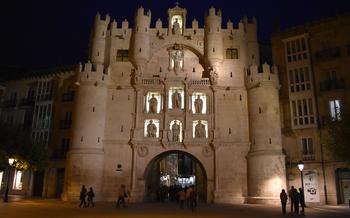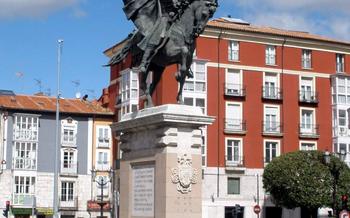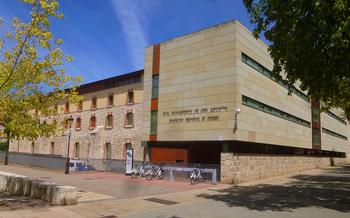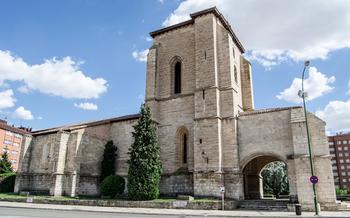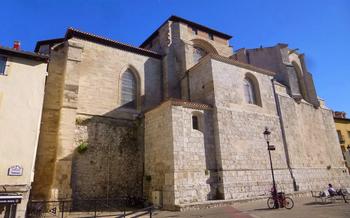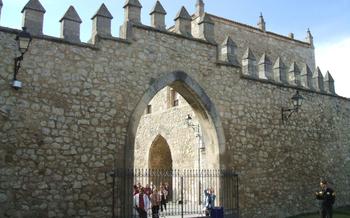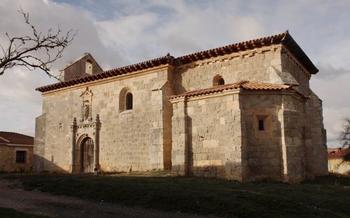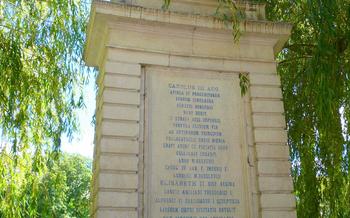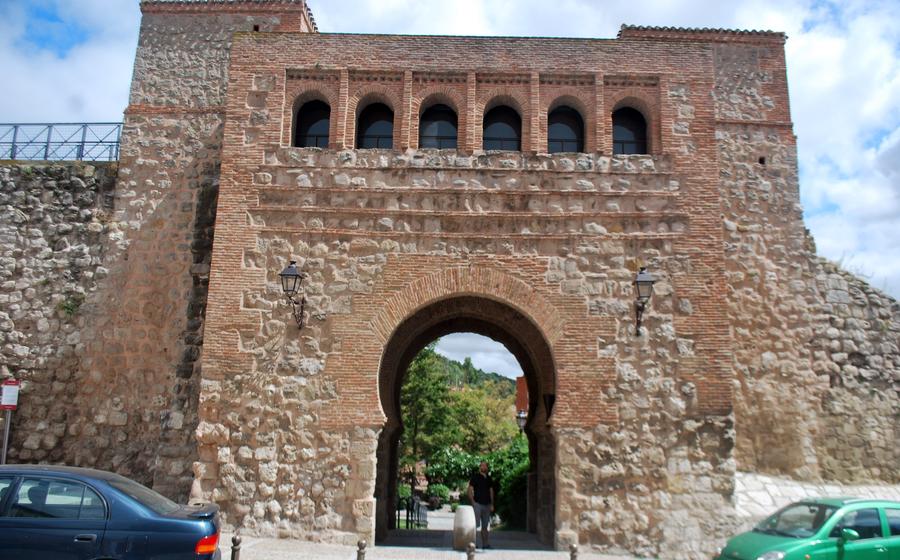
Arco de San Esteban
- A City of History and Heritage
- Arco de San Esteban - A Gateway to the Past
- Exploring the Arch's Exterior
- The Arch's Interior - A Hidden Treasure
- Adjoining Buildings and Structures
- The Arch as a Symbol of Burgos
- Restoration and Preservation Efforts
- The Arch in Literature and Art
- The Arch as a Tourist Destination
- Arco de San Esteban and the Camino de Santiago
- The Arch at Night
- Insider Tip - Hidden Gems Nearby
A City of History and Heritage
Burgos, a city steeped in history and architectural splendor, is a testament to its rich cultural heritage. Its historical significance dates back to the Middle Ages when it served as the capital of the Kingdom of Castile. The city boasts a remarkable blend of architectural styles, from Gothic to Renaissance and Baroque, reflecting its diverse past. Burgos is home to several UNESCO World Heritage Sites, including the stunning Burgos Cathedral, a masterpiece of Gothic architecture, and the Atapuerca archaeological sites, which have yielded significant findings about human evolution. Must-see landmarks include the Cartuja de Miraflores, a former monastery known for its elaborate Gothic cloister, and the Casa del Cordón, a 15th-century palace adorned with intricate carvings.
Arco de San Esteban - A Gateway to the Past
The Arco de San Esteban stands proudly in the heart of Burgos, a silent sentinel guarding the city's rich history. Located at the end of Calle Fernán González, the arch forms a picturesque passageway connecting the Plaza del Rey San Fernando with the Plaza de San Esteban, two of the city's most iconic squares. This impressive structure is a testament to the architectural prowess of the 16th century, blending Gothic and Renaissance elements in a harmonious fusion that has withstood the test of time.
The arch's imposing façade immediately captivates the eye with its intricate carvings and decorative elements. The archway is flanked by two semi-circular towers, their surfaces adorned with delicate tracery, gargoyles, and pinnacles that seem to reach for the sky. Above the archway, a series of niches houses statues of saints and biblical figures, adding a touch of spirituality to this architectural masterpiece.
The Arco de San Esteban holds immense historical significance. Built in the mid-16th century, it served as a gateway to the city's Jewish quarter, which was located in the area around the Plaza de San Esteban. The arch's construction coincided with a period of economic prosperity and cultural flourishing in Burgos, as evidenced by the intricate details and craftsmanship that went into its creation. Today, the arch stands as a reminder of the city's rich past, a symbol of its resilience and enduring spirit.
Exploring the Arch's Exterior
The exterior of the Arco de San Esteban is a testament to the artistry and craftsmanship of its creators. Intricate carvings and sculptures adorn the arch, depicting scenes from the Bible, mythology, and daily life. Angels, saints, and mythical creatures come to life in stone, each with its own unique story to tell. The arch's decorative elements are not merely ornamental; they carry deep symbolic meaning, representing virtues, vices, and the triumph of good over evil.
The arch's architectural details are equally impressive. The pointed arches, ribbed vaults, and flying buttresses are characteristic of the Gothic style, which was popular in Europe during the Middle Ages. The use of these elements not only enhances the arch's structural stability but also creates a sense of height and grandeur.
Over time, the arch's exterior has been weathered by centuries of wind and rain, acquiring a beautiful patina that adds to its character. The worn and eroded surfaces tell a story of the arch's long and eventful history, bearing witness to the passage of time and the changing fortunes of Burgos.
The Arch's Interior - A Hidden Treasure
Venturing beyond the arch's imposing exterior reveals a hidden treasure - its interior chamber. Originally designed as a passageway connecting the city's medieval streets, this enclosed space served various purposes throughout history. Its architectural features reflect the ingenuity and craftsmanship of its creators.
The interior of the Arco de San Esteban is characterized by its vaulted ceiling, supported by sturdy stone arches. The walls are adorned with intricate carvings and sculptures, depicting religious scenes, mythical creatures, and symbols of power. These decorative elements offer a glimpse into the artistic and cultural influences that shaped Burgos during its golden age.
Historically, the arch's interior served as a meeting place for city officials, a shelter for travelers seeking refuge from the elements, and even a temporary prison during times of unrest. Today, the interior space is accessible to visitors, offering a unique perspective on the arch's history and significance.
Adjoining Buildings and Structures
The Arco de San Esteban is seamlessly intertwined with its surrounding architectural landscape, forming a cohesive ensemble that reflects the city's rich history. Adjoining the arch are several notable buildings that contribute to the overall significance of the area.
To the immediate left of the arch stands the Casa del Cordón, a magnificent 15th-century palace renowned for its impressive façade adorned with intricate stone carvings. It was once the residence of the constable of Castile, a high-ranking official in the royal court, and its grandeur reflects the power and influence of its former occupants.
Adjacent to the Casa del Cordón is another historic building, the Palacio de los Condestables de Castilla. This 16th-century palace, with its elegant Renaissance-style architecture, served as the residence of the counts of Castile, further solidifying the area's connection to the city's elite.
On the opposite side of the arch, visitors will find the Hospital del Rey, a former hospital founded in the 12th century and rebuilt in the 16th century. Its Gothic-style architecture and cloistered courtyard offer a glimpse into the city's rich healthcare history.
These adjoining buildings, with their distinct architectural styles and historical significance, create a vibrant tapestry that enriches the experience of visiting the Arco de San Esteban. Together, they paint a vivid picture of Burgos's past, showcasing the city's architectural evolution and the interconnectedness of its landmarks.
The Arch as a Symbol of Burgos
The Arco de San Esteban stands as, and architectural legacy. It is a testament to the skill and artistry of the city's builders and serves as a reminder of the important role that Burgos played in the development of the region. The arch has become an iconic landmark, symbolizing the resilience and pride of the Burgalese people. It is featured prominently in local iconography, artwork, and literature, and serves as a source of inspiration for local artists, musicians, and writers. The arch is also a popular tourist destination, drawing visitors from around the world who come to admire its beauty, learn its history, and experience its unique atmosphere.
Restoration and Preservation Efforts
The Arco de San Esteban, like many historical landmarks, has faced challenges due to the passage of time, weathering, and human impact. Recognizing its cultural significance, significant efforts have been made to preserve and restore the arch, ensuring its longevity and continued appreciation.
Preserving a historical landmark like the Arco de San Esteban requires a multifaceted approach. Conservation experts and stakeholders collaborate to assess the arch's condition, identify areas of concern, and develop appropriate restoration techniques. These techniques may involve cleaning and repairing the stonework, reinforcing structural elements, and addressing any damage caused by environmental factors.
In undertaking restoration work, the goal is to maintain the arch's original character and integrity while ensuring its stability and safety. This delicate balance requires skilled craftsmanship, attention to detail, and a deep understanding of the arch's historical context.
The successful preservation of the Arco de San Esteban serves as a testament to the importance of safeguarding our cultural heritage. Through ongoing conservation efforts, future generations can continue to admire and appreciate this architectural gem, preserving its legacy as a symbol of Burgos' rich history and heritage.
The Arch in Literature and Art
The Arco de San Esteban has served as a muse for many artists and writers throughout history. Its majestic presence and historical significance have been captured in paintings, drawings, and sculptures, each offering a unique perspective on this architectural masterpiece. In literature, the arch has been immortalized in poems, stories, and novels, where it often serves as a backdrop for historical events or as a symbol of the city's rich heritage. These creative depictions not only showcase the arch's beauty and grandeur but also contribute to its cultural and artistic legacy.
One notable painting is "Arco de San Esteban, Burgos" by the renowned Spanish artist Joaquín Sorolla y Bastida. The painting, created in 1915, depicts the arch in all its glory, bathed in warm sunlight and surrounded by a bustling city scene. Sorolla's vibrant brushstrokes and masterful use of light bring the arch to life, capturing its intricate details and the energy of the surrounding environment.
In literature, the Arco de San Esteban has been featured in works by renowned authors such as Miguel de Cervantes and Federico García Lorca. In Cervantes's classic novel "Don Quixote," the arch is mentioned as a landmark that the wandering knight encounters during his travels. García Lorca, in his poem "Romance de la Guardia Civil Española," uses the arch as a symbol of the city's resilience and resistance against oppression.
These artistic and literary representations of the Arco de San Esteban not only showcase the arch's historical and cultural significance but also contribute to its enduring legacy as a symbol of Burgos and a source of inspiration for generations to come.
The Arch as a Tourist Destination
The Arco de San Esteban is a popular tourist destination in Burgos, attracting visitors from around the world. Its historical significance, architectural beauty, and unique location make it a must-see for anyone interested in the city's rich heritage. Guided tours are available for those who want to learn more about the arch's history and symbolism, while self-exploration is also an option for independent travelers. Visitor information centers and local guides can provide maps, brochures, and recommendations to enhance the experience. The arch is easily accessible on foot or by public transportation, making it a convenient stop on any Burgos itinerary.
Arco de San Esteban and the Camino de Santiago
The Arco de San Esteban route that has drawn countless travelers to northern Spain for centuries. The arch served as a symbolic gateway for pilgrims entering the city of Burgos, a major stop along the route.
For pilgrims, passing through the Arco de San Esteban marked a milestone in their journey. It represented not only a physical entry into the city but also a spiritual transition, as they left behind the challenges of the open road and entered a place of sanctuary and rest. The arch provided a sense of arrival and accomplishment, reinforcing the spiritual and emotional significance of the pilgrimage.
The arch's location at the heart of the city also allowed pilgrims to connect with the local community and immerse themselves in the cultural and religious traditions associated with the Camino. They could attend Mass at the nearby Cathedral of Burgos, visit other sacred sites, and interact with local people who offered them hospitality and support.
Today, the Arco de San Esteban continues to be a focal point for pilgrims walking the Camino. Many choose to pause at the arch, reflect on their journey, and seek inspiration and guidance as they prepare for the next leg of their pilgrimage. The arch serves as a reminder of the enduring spirit of the Camino de Santiago, where history, faith, and personal transformation intertwine.
The Arch at Night
As the sun sets over Burgos, the Arco de San Esteban transforms into a mesmerizing spectacle. The arch is skillfully illuminated, casting a warm glow on its intricate carvings and architectural features. This nocturnal illumination enhances the arch's grandeur and creates a captivating atmosphere that draws visitors and photographers alike.
Strolling through the surrounding streets at night, you'll be greeted by a unique blend of history and modernity. The arch's illuminated silhouette against the backdrop of the starry sky offers a breathtaking sight, making it a perfect spot for capturing stunning photographs.
The night also brings a different perspective to the arch's surroundings. The play of light and shadow accentuates the arch's architectural details, revealing hidden nuances and textures often missed during the day. Take your time to explore the surrounding area, where the illuminated arch casts a warm glow on the cobblestone streets and nearby buildings.
While the arch itself is closed to visitors at night, its exterior remains accessible, allowing you to admire its beauty from various angles. Take advantage of this opportunity to wander around the arch, marveling at its illuminated grandeur and soaking in the tranquil ambiance of the night.
Insider Tip - Hidden Gems Nearby
Venturing beyond the arch itself, a wealth of hidden gems awaits exploration. Just a short stroll away, the enchanting Plaza de la Libertad beckons with its tranquil ambiance and charming cafes. For a culinary adventure, seek out the unassuming Restaurante Casa Ojeda, where traditional Spanish cuisine is lovingly prepared and served with a smile. History buffs will delight in the Museo de Burgos, which houses a fascinating collection of artifacts and exhibits chronicling the city's rich past. And for those with a sweet tooth, a visit to the Pastelería San Esteban is a must, where mouthwatering pastries and confections are crafted with artistry and passion.
Remember, the true essence of a city often lies in its hidden corners, so embrace the spirit of curiosity and let Burgos reveal its secrets to you.
